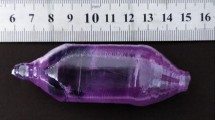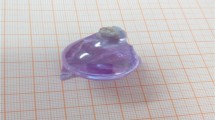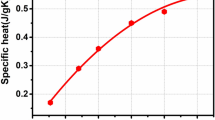Abstract
We report the optical and structural properties of helium-implanted optical waveguides in Nd:MgO:LiNbO3 laser crystals. The prism-coupling method is used to investigate the dark-mode properties at the wavelength of 632.8 nm. The spontaneous generation of ultraviolet, blue, red, and near-infrared fluorescence emissions is demonstrated under excitation with an 808-nm laser diode. The effects of ion irradiation on the structural properties are characterized using the high-resolution X-ray diffraction technique. The results show that the initial luminescence properties of Nd:MgO:LiNbO3 crystals are slightly modified by irradiation with 2.8 MeV He ions at fluences of 1.5 × 1016 ions/cm2 at room temperature.
Similar content being viewed by others
Avoid common mistakes on your manuscript.
1 Introduction
Lithium niobate (LiNbO3) is an outstanding and widely studied optoelectronic material in advanced photonics and nonlinear optics because of its unique combination of many excellent features [1]. Furthermore, rare-earth-doped LiNbO3 has received significant attention as an attractive material for a broad range of solid-state laser sources and amplifiers of highly compact amplifiers [2]. In particular, the trivalent Nd3+-ion-doped LiNbO3 crystal is a promising laser gain medium to develop integrated optoelectronic devices, because the laser properties of the active Nd3+ ions and the excellent electro-optical and nonlinear optical properties of LiNbO3 provide the possibility of constructing many interesting systems such as multi-functional laser sources [3,4,5]. For those potential applications, the optical waveguide configuration design is particularly relevant to achieve high photon density and optical conversion efficiencies. Various techniques have been used to fabricate optical waveguides in LiNbO3, such as metal in-diffusion, proton exchange, ion implantation, and femtosecond laser writing [6,7,8]. Among different methods to fabricate LiNbO3 waveguides, an effective and competitive method is the use of ion implantation with energetic light ions (H, He) or heavier ions (C, O, F) [9]. In many cases, energetic He ions have been implanted into LiNbO3 to produce low-loss optical waveguides with fluences of ~1016 ions/cm2 [10]. In general, energetic He+- or H+-ion-implanted LiNbO3 waveguides have been demonstrated to be typical barrier-confined waveguides, where the two-layered structure is formed. In the near-surface guiding region, where electronic processes are dominant, the initial crystal properties are only slightly modified by the energetic-ion implantation. However, the low-index optical barrier occurs at the end of the ion track, where the nuclear collisions become the dominant mechanism of energy transfer, and ion stopping is actively developed. More recently, optical waveguides in Nd:MgO:LiNbO3 have been formed by energetic H, C, and O ion implantation, and the corresponding fluorescence properties are investigated [11,12,13]. According to the literature on ion-implanted Nd:MgO:LiNbO3, the main issues are the characterization of optical properties, which include the guiding modes, and emission of luminescence in the infrared region. Despite these impressive advances, the physics of the effect of irradiation on the structural and optical properties of Nd:MgO:LiNbO3 has not been fully explored. In addition, there is ongoing demand for better performing materials in high-power applications or broader spectra for different laser concepts. To our knowledge, the irradiation effect on the optical and structural performance of Nd:MgO:LiNbO3 by He ion implantation has not been demonstrated. Thus, the optical and structural responses of Nd:MgO:LiNbO3 to ion irradiation must be thoroughly understood. In the present work, we report the fabrication of optical waveguides in Nd:MgO:LiNbO3 crystals irradiated by 2.8-MeV He ions at fluences of 1.5 × 1016 ions/cm2, and we investigate the guiding, fluorescence and structural properties.
2 Experiments
The x-cut Nd:MgO:LiNbO3 crystals (doped with 0.5 at% Nd3+ and 4.0 at% MgO) were implanted by 2.8-MeV He ions with doses of 1.5 × 1016 ions/cm2 at room temperature on an NEC 2 × 1.7 MV Tandem Accelerator in the Ion Beam Materials Laboratory at Peking University. During the implantation, all samples were titled by 7° off the ion beam direction to minimize the channeling effect. Then, some samples were annealed at 260 ºC for 30 min in ambient oxygen. The prism-coupling method was used to confirm the formation of waveguides and record the dark modes with the Model 2010 Prism Coupler (Metricon 2010). The excitation, up-conversion, and near-infrared fluorescence emission spectra of both pristine and implanted samples were measured on a Jobin-Yvon FLUOROLOG-3-TAU spectrometer under excitation with an 808-nm laser diode. In this work, the fluorescence was measured at a 90º angle to the incident light to obtain a better signal-to-noise ratio and a lower detection limit. Both implanted and pristine samples were characterized by high-resolution X-ray diffraction recorded on a Bruker D8 Discover. A 2θ–ω scanning mode was performed near the (300) Bragg reflection plane with a resolution of 0.001º.
3 Results and discussion
In general, there are two different types of damage produced in irradiation processes, which can be described and numerically simulated using the software Stopping and Range of Ions in Matter (SRIM) 2013. Figure 1 shows the damage profiles induced by 2.8-MeV irradiation of He ions into Nd:MgO:LiNbO3 crystals. The incident He ions clearly lost most of their energy through electronic ionizations (electronic stopping power) along the trajectory in the target, which remained at a high level from the surface and reached a maximum of 5.0 µm depth. In contrast to the observations in the electronic stopping regime, nuclear collisions (nuclear stopping power) mainly occurred at the end of the ion track, which caused the partial lattice disorder that usually accompanies a physical density reduction, and consequently created an optical barrier at approximately 6.5 µm.
By applying the prism-coupling measurement, the dark-mode spectra of the planar waveguides in Nd:MgO:LiNbO3, which were implanted with 2.8 MeV He ions at fluences of 1.5 × 1016 ions/cm2, were detected with a Model 2010 prism coupler at the wavelength of 632.8 nm. Figure 2 shows the intensity spectra of (a) transverse magnetic (TM) and (b) transverse electric (TE) polarized light that was reflected from the prism versus the effective refractive indices of the incident light. The refractive indices of the substrate are also provided for comparison. In detail, Fig. 2a shows a typical “optical-barrier-confined” waveguide, because all effective refractive indices (n eff) of the dark-mode lines are less than that of the substrate (n 0 = 2.2864), where more than 20 dips of the excited TM mode were measured. Among these, the first 11 narrow and sharp dips with a large n eff may correspond to the real guiding modes in a planar waveguide, which implies that the light in these modes can be well confined by the optical barrier. The subsequent dips became increasingly broad, because more light increasingly tunnels out of the barrier by decreasing the effective refractive indices of the incident light, which represent the so-called “substrate modes”. However, as shown in Fig. 2b, when the laser beam was used with TE polarization, there are four sharp dips in the dark-mode line spectra in the Nd:MgO:LiNbO3 waveguide formed by 2.8-MeV He ion irradiation at fluences of 1.5 × 1016 ions/cm2. The corresponding TE modes are confined by the n e-raised region because of the higher n eff than that of substrate (n e = 2.2028). Simultaneously, the coexistence of the shallow and broad dips in the tip of the mode profile indicates that the waveguide exhibits some characteristics of a barrier-confined waveguide.
The photoluminescence excitation and near-infrared emission spectra of the Nd:MgO:LiNbO3 are shown in Fig. 3. In Fig. 3a, the photoluminescence excitation spectra monitored at 1084 nm exhibit nine bands centered at 367, 442, 481, 536, 597, 690, 757, 816, and 890 nm, and the corresponding excited levels are labeled in the spectra. The excitation spectra show that the strongest band is centered at 597 nm because of the 4I9/2 → 4G5/2, 2G7/2 transition. Figure 3b demonstrates the room temperature near-infrared emission spectra of both pristine and implanted samples upon excitation by the 808-nm laser, which consists of three major emission bands in the ranges of 885–935, 1055–1135, and 1320–1450 nm. Already, well addressed is that after excitation of the 9H9/2–4F5/2 multiplet, the Nd3+ ions mainly relax with non-radiative decay in the metastable 4F3/2 level, which generates the recorded emissions of the transitions from 4F3/2 to 4I9/2, 4I11/2, and 4I13/2. The transitions from 4F3/2 to 4I9/2 mainly include several peaks at approximately 876, 888, 901, 914, and 926 nm; the transitions from 4F3/2 to 4I11/2 are composed of the peaks around 1079, 1084, 1093, and 1105 nm; and the transitions from 4F3/2 to 4I13/2 mainly include the peaks at 1364, 1374, 1387, and 1403 nm. In addition, the fluorescence intensity at 1084 nm is much stronger than that at other wavelengths. In brief, the present measurements show that a reasonable energy transfer mechanism is that the exciton energy of the 808-nm laser is transferred to promote the Nd3+ ions from the fundamental state to the 4F5/2 level; then, a non-radiative relaxation from this excited state to 4F3/2 occurs. Regarding the transitions from 4F3/2 to 4I11/2, four satellite peaks are present in the amplification of the major emission bands in the range of 1055–1135 nm, which originate from four main non-equivalent types of Nd3+ centers in the doubly doped Nd:MgO:LiNbO3 crystals, as shown in the Fig. 3b inset. According to the literatures, rare-earth ions in LiNbO3 basically may substitute for Li+ or Nb5+ in the host matrix [14]. Therefore, three Nd3+ centers correspond to different positions of the Nd3+ ions in the octahedron because of different charge compensation mechanisms when the trivalent Nd3+ ions substitute for the Li+ or Nb5+ ions into the host crystal. In addition, a new Nd3+ center, which is denoted as Nd–Mg, appears in the doubly doped Nd:MgO:LiNbO3 crystals. The inset of Fig. 3b clearly shows that the luminescence intensity slightly increases after the implantation. There are several typical uncertainties in luminescence intensity detection, such as instrument- and sample-related factors. In particular, the exciting light source power varies over time during the measurements. In the present work, the diode laser operates at 808 nm with a power stability below 0.5%, which is much smaller than the intensity difference between the achieved spectra. Hence, the luminescence properties of Nd:MgO:LiNbO3 can be effectively modified by the irradiation of 2.8-MeV He ions at fluences of 1.5 × 1016 ions/cm2.
Nd3+ ions with 17 spectroscopic terms and 41 energy levels can provide multiple channels for the up-conversion process [15]. Recently, the development of Nd3+-doped LiNbO3 as up-conversion materials is of great significance for applications such as solid-state multicolor display, high-density memories, and photonic applications [16]. Figure 4a shows the room temperature up-conversion emission spectra in the wavelength range of 300–650 nm upon excitation with a 808-nm laser, which consists of three major emission bands centered at 361, 441, and 622 nm. In detail, the ultraviolet emission band centered at 361 nm can be assigned to the Nd3+: 4D3/2 → 4I9/2 transitions, the blue emission peak at 441 nm can be assigned to the Nd3+: 2P1/2 → 4I9/2 transitions, and the intensive red line at 622 nm corresponds to the Nd3+: 4G5/2 → 4I9/2 transitions. Figures 3b and 4a show that the spontaneous UC and NIR emission spectra recorded in the implanted specimen highly resemble those in the pristine crystal, which exhibits notably similar shape and intensity. Therefore, the spectral characteristics of Nd3+ ions in the Nd:MgO:LiNbO3 crystal can be well reserved after the irradiation of 2.8 MeV He ions at fluences of 1.5 × 1016 ions/cm2. The corresponding chromaticity Commission International I’Eclairage (CIE) coordinates of the Nd3+ fluorescence of the pristine Nd:MgO:LiNbO3 crystals are also shown in Fig. 4b.
XRD has been demonstrated as a powerful tool for material science, which enables the non-destructive characterization of the crystallinity, composition, and residual stress in thin films and bulk materials. XRD is also an effective method to determine the effect of structural defects, disorder and strain on the crystalline perfection in crystals irradiated with energetic ions. In general, the deformation of a crystal lattice results in a change in interatomic distances; in addition, the variation of the crystallite makes the diffraction peaks broaden and shifts. In this work, the effect of the strain, structural defects, and disorder on the crystalline perfection of implanted Nd:MgO:LiNbO3 is further analyzed by high-resolution X-ray diffraction studies on Bruker D8 Discover with a single CuKα1 line of wavelength λ = 1.54056 Å. Figure 5 shows the 2θ/ω scans of the (300) reflection for both pristine and implanted samples, where the bulk peaks are indicated by arrows. For the pristine sample, only one symmetric (300) diffraction curve is recorded at ~62.54º with FWHM of ~0.034º. However, the diffraction pattern of the implanted sample reveals the obvious presence of perpendicular compressive strain in Nd:MgO:LiNbO3 induced by irradiation with 2.8-MeV He ions at fluences of 1.5 × 1016 ions/cm2, as indicated by the decreasing angle of the (300) diffraction peak (~62.43º). According to Bragg equation, a left-shifted peak indicates a lattice expansion. Furthermore, the tail of scattered intensity toward the smaller angle side of the (300) main Bragg peak consists of two new asymmetrical satellite peaks, whose location and intensity should indicate the magnitude and size of the in-plane compressive strains in the implanted region. Another important feature of the diffraction pattern is that the higher integrated intensity is observed for the implanted-related peak, which suggests a relatively poor crystalline perfection with respect to the pristine. As mentioned the literatures, the in-plane compressive strain can be originate from the implantation-induced lattice distortion and volume expansion in the heavily damaged region [17, 18].
4 Conclusion
In summary, we report the optical planar waveguides in Nd:MgO:LiNbO3 laser crystals by 2.8-MeV He ion implantation at fluences of 1.5 × 1016 ions/cm2 at room temperature. Both TM and TE guided modes were measured by the prism-coupling method at the wavelength of 632.8 nm. For the TE mode, we have found that the helium-ion-irradiated Nd:MgO:LiNbO3 waveguides exhibit hybrid optical properties of both “optical-barrier-confined” and “index-raised” characteristics. The spontaneous generation of ultraviolet, blue, red, and near-infrared fluorescence emissions was investigated under excitation with an 808-nm laser diode. We also provide the experimental evidence of an absence of any deterioration in the luminescence properties of Nd:MgO:LiNbO3 crystals. The fabricated structures are good candidates for the development of nonlinear integrated laser sources.
References
L. Wang, C.E. Haunhorst, M.F. Volk, F. Chen, D. Kip, Opt. Exp. 23, 30188 (2015)
W.-Y. Du, Z.-B. Zhang, S. Ren, W.-H. Wong, D.-Y. Yu, E.Y.-B. Pun, D.-L. Zhang, IEEE Photon. Tech. L. 28, 2503 (2016)
H. Chu, J. Zhao, T. Li, S. Zhao, K. Yang, D. Li, G. Li, W. Qiao, Y. Sang, H. Liu, Opt. Mater. Exp. 5, 684 (2015)
M.Q. Fan, T. Li, S.Z. Zhao, G.Q. Li, D.C. Li, K.J. Yang, W.C. Qiao, S.X. Li, Opt. Mater. 53, 209 (2016)
M.Q. Fan, T. Li, S.Z. Zhao, H. Liu, Y. Sang, G.Q. Li, D.C. Li, K.J. Yang, W.C. Qiao, S.X. Li, Appl. Opt. 54, 9354 (2015)
C.-L. Jia, Y. Jiang, X.-L. Wang, F. Chen, L. Wang, Y. Jiao, K.-M. Wang, J. Appl. Phys. 100, 033505 (2006)
J.M. de Mendivil, J. de Hoyo, J. Solis, G. Lifante, Opt. Mater. 62, 353 (2016)
J.M. Lv, X.T. Hao, F. Chen, Opt. Exp. 24, 25482 (2016)
F. Chen, J. Appl. Phys. 106, 081101 (2009)
T.R. Volk, L.S. Kokhanchik, R.V. Gainutdinov, Y.V. Bodnarchuk, S.M. Shandarov, M.V. Borodin, S.D. Lavrov, H. Liu, F. Chen, J. Lightwave Technol. 33, 4761 (2015)
D. Jaque, F. Chen, Appl. Phys. Lett. 94, 011109 (2009)
D. Jaque, F. Chen, Y. Tan, Appl. Phys. Lett. 92, 161908 (2008)
N.-N. Dong, F. Chen, D. Jaque, Opt. Exp. 18, 5951 (2010)
L. Rebouta, M.F. da Suva, J.C. Soares, J.A. Sanz-Garcia, E. Dieguez, F. Agulló-López, Nucl. Instr. Meth. Phys. Res. B 64, 189 (1992)
M. Nakamura, M. Sekita, S. Takekawa, K. Kitamura, J. Cryst. Growth 290, 144 (2006)
A.-H. Li, Z.-R. Zheng, Q. Lü, L. Sun, W.-L. Liu, J. Appl. Phys. 105, 013536 (2009)
A. Ofan, L. Zhang, O. Gaathon, S. Bakhru, H. Bakhru, Y. Zhu, D. Welch, R.M. Osgood, Phys. Rev. B 82, 104113 (2016)
C. Ma, F. Lu, B. Xu, R. Fan, J. Phys. D Appl. Phys. 49, 205301 (2016)
Acknowledgements
This work is supported by “the Fundamental Research Funds for the Central Universities” (Grant No. 2015XKMS083). We are also grateful to the State Key Laboratory of Nuclear Physics and Technology of Peking University for help with ion implantation.
Author information
Authors and Affiliations
Corresponding author
Rights and permissions
About this article
Cite this article
Jia, CL., Li, S. & Song, XX. Optical and structural properties of Nd:MgO:LiNbO3 crystal irradiated by 2.8-MeV He ions. Appl. Phys. B 123, 206 (2017). https://doi.org/10.1007/s00340-017-6783-y
Received:
Accepted:
Published:
DOI: https://doi.org/10.1007/s00340-017-6783-y









